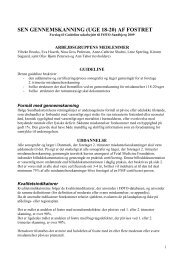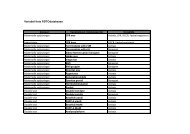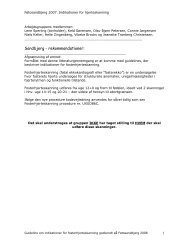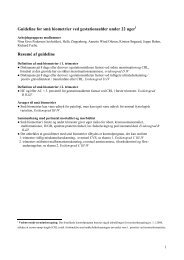Risikovurdering i 2. trimester vedr. Downs syndrom - DFMS
Risikovurdering i 2. trimester vedr. Downs syndrom - DFMS
Risikovurdering i 2. trimester vedr. Downs syndrom - DFMS
Create successful ePaper yourself
Turn your PDF publications into a flip-book with our unique Google optimized e-Paper software.
Jona JZ. Allantoic cyst and persistent urachal-allantoic communication: a rare umbilical anomaly. J<br />
Pediatr Surg 1998; 33:1441-144<strong>2.</strong><br />
Fuchs F et al. Prenatal diagnosis of a patent urachus cyst with the use of 2D, 3D, 4D ultrasound<br />
and fetal magnetic resonance imaging. Fetal Diagn Ther 2008;24: 444-447.<br />
Zangen R et al. Umbilical cord cysts in the second and third <strong>trimester</strong>s: significance and prenatal<br />
approach. Ultrasound Obstet Gynecol 2010;36: 296-301.<br />
Pyelektasi DQ620C, DQ620D<br />
Pyelektasi defineres i forhold til risiko for Down <strong>syndrom</strong> som et nyrepelvis med anteroposterior<br />
diameter ≥ 4 mm i et transverselt snit. Skønsmæssigt har ca. 17 % af fostre med Down <strong>syndrom</strong><br />
pyelektasi. Isoleret pyelaktasi ses imidlertid kun sjældent hos DS fostre, i tre separate studier er<br />
dette kun angivet i 1:300 fostre med isoleret pyelaktasi. Skønt LR angives til 1,9 i Smith-Bindmans<br />
store metaanalyse, gik CI under 1,0, hvilket har medført, at man altså nu ikke betragter pyelektasi<br />
som en brugbar markør for DS, når den optræder isoleret.(Evidensgrad I)<br />
Referencer for pyelektasi:<br />
M. Bethune. Literature Review and suggested protocol for managing ultrasound soft markers for<br />
Down <strong>syndrom</strong>e: Thickened nuchal fold, echogenic bowel, shortened femur, shortened humerus,<br />
pyelectasis and absent or hypoplastic nasal bone. Australas Radiol. 2007;51:324-9.<br />
Benacerraf BR.. The history of the second-<strong>trimester</strong> sonographic markers for detecting fetal Down<br />
<strong>syndrom</strong>e, and their current role in obstetric practice. Prenat. Diagn.2010;30: 644-65<strong>2.</strong><br />
31






